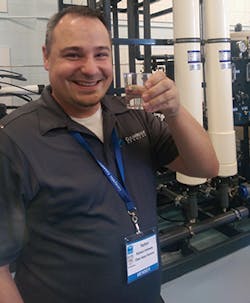Stormwater mitigation approaches are a complex web of solutions. Nathan Holloway’s job is to help clients sort them out while balancing budgets and regulatory concerns. Holloway has developed training and outreach programs demonstrating which technologies perform best in different applications, “and appropriate means and methods for evaluating design, performance, and operational practices across multiple cost scenarios so that engineers, consultants, regulators, contractors, and project owners can make informed decisions about their stormwater treatment objectives and risks,” he says.
Holloway is vice president of Clear Water Services in Seattle, WA. The company began in 1998 after new phases of the Clean Water Act and the Endangered Species Act increased the need for specialized erosion control and water treatment services at construction and industrial sites. It was one of the first independent companies given authorization to perform water treatment at construction sites on behalf of the general contractor. The small environmental services firm provides water treatment solutions for construction projects, industrial facilities, and municipalities—aggregating equipment that best meets clients’ water treatment needs. The most utilized technologies include chitosan-enhanced sand filtration, multi-media filtration and adsorption, chemical oxidation and polymer-assisted filtration, and enhanced low-impact development.
What He Does Day to Day
Holloway works with contractors, industrial facilities, engineers, consultants, and staff members to design, build, operate, and maintain active treatment systems for large-scale projects. After spending time training staff and clients on the capabilities of the treatment technologies that best meet a project’s needs, he provides support to staff as they lead clients through the various project phases.
What Led Him to This Line of Work
As a child contemplating a future career, Holloway set his sights on the outdoors. “I have always felt a connection with the natural environment, especially anything to do with water,” he says. Holloway was an Oceanography and Environmental Sciences major in college, spending significant time working on research vessels out at sea. “I quickly learned I didn’t want to make a career of it.” He worked his way through college in construction and restaurant service, and then started working as a Clear Water technician a few years after earning a BS/BA in environmental science, oceanography, fisheries, and environmental policy from the University of Washington. “I liked that I could use all of my work experiences to grow my career in an expanding technical services market. Back when I was a kid, I didn’t realize working outside would involve getting soaked in the rain on a daily basis.”
What He Likes Best About His Work
“What I find amazing about our work is the immediate positive impact to the environment we are providing,” says Holloway. “Oftentimes at work, people can get frustrated and feel like they are not making much of a difference in the world; but when you look at the stark contrast in water quality going into versus coming out of our systems, it’s pretty impressive and makes us all feel good about what we do and that our work is actually making the world a better place.”
“One of the challenges we face is the inaccurate notion that water treatment is too expensive and should only be used as a last resort,” notes Holloway. “Treatment can occur in various forms, ranging in cost and complexity based on site conditions, but there certain industrial and construction projects in which treatment is the only viable option to meet water-quality benchmarks, and there are always creative and economic solutions available.” The key is recognizing the site conditions that will surely require treatment and then finding the right balance of source control and operational and treatment BMPs all working together, says Holloway. “The adaptive nature of the permits and the cost sensitivity to treatment technologies usually perpetuates a reactionary and rushed implementation schedule,” he contends. “Industrial facilities and construction companies spend a lot of time and money implementing low-cost solutions that simply don’t work for the complexity of their sites. To avoid regulatory fines or third-party lawsuits, they are forced to upgrade to more advanced treatment technologies and services—sometimes on an emergency basis. That makes it cost more.”

